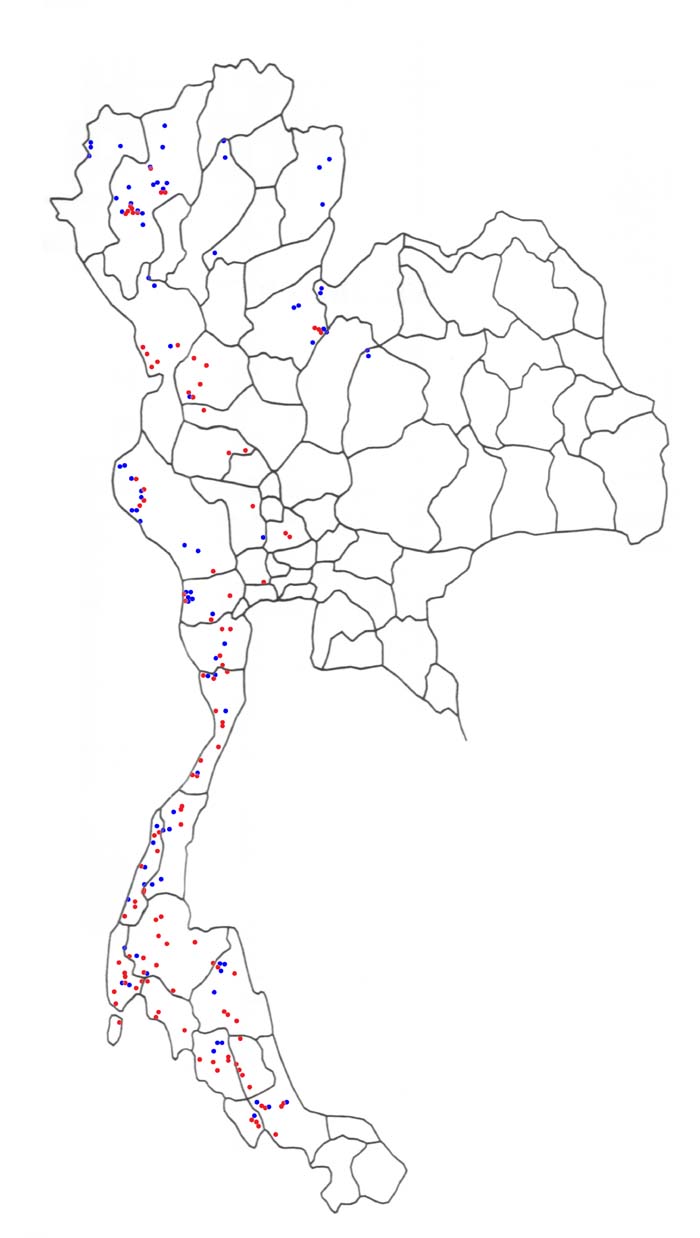
This is a summary of the scientific aspects of my (Mike's) journey through Thailand in 2003. I put this together from a poster I presented at the national meeting of the Entomological Society of America in Cincinnati, Ohio. It took approximately 4 months to identify nearly all of the 1515 adult specimens that were collected during the trip. More than 100 species of dragonfly and damselfly were collected and I was able to identify more than 90. Two species (undescribed to science) were collected. This is nothing more than an informal summary of my activities.
Comments? Questions? Email me at spongymesophyll@gmail.com
Biogeography of the Odonata of Thailand with Association of Adults and Larvae
Michael Ferro (spongymesophyll@gmail.com)
Robert W. Sites
University of Missouri-Columbia, Department of Entomology, 1-87 Agriculture
Bldg, Columbia, MO
Abstract
Adult and larval Odonata were collected in Thailand during May through July, 2003. Approximately 200 sites were sampled, which represented nearly the entire north/south axis of the country (approximately 18° N through 6° N). Both highland and lowland aquatic habitats (i.e., streams, waterfalls, ponds, rice paddies, and springs) were sampled, resulting in the collection of over 2,000 adult and larval specimens. Rearing of larvae and collection of teneral adults and exuviae yielded adult and larval associations. Numerous range extensions as well as biogeographical and ecological information concerning Thai Odonata is presented.
Introduction
The Odonata (dragonflies and damselflies) is an ancient order of insects of interest to casual naturalists as well as to scientists focusing on questions of environmental contamination or community ecology.
Whereas the odonate fauna of well-studied regions such as the United States or Europe are nearly completely known, the odonate fauna of Southeast Asian countries is poorly known at best. The 1999 Atlas of the Dragonflies of Thailand (Hämäläinen and Pinratana, 1999) summarized the current state of Thai odonatology and listed 315 species, of which 20 are still undescribed, 50 known from 3 or fewer specimens, 31 listed as rare, 33 listed as uncommon, and 92 collected from only one province.
In stark contrast to adults, the larvae of Thai odonates are nearly completely unknown, which clearly handicaps any research addressing ecological or environmental questions in aquatic systems. In fact fewer than a half dozen Thai species can be identified in the larval stage.
The goals of this study are to (1) improve our understanding of the geographic and temporal distribution of species and (2) advance our knowledge of the larval fauna by associating unknown larvae with identifiable adults.
Methods
Collecting of adult odonates was conducted from the northern province of Chiang Mai to the southern province of Songkhla from March through June 2003. One hundred twenty four locations were sampled (Fig. 1, red dots, see below). Larvae were also sampled in previous years ((not by me, Fig. 1, blue dots). Larvae in their final instar were collected live and reared to the adult stage in the field.
Visual observation of emergent vegetation and shoreline structure at each location yielded emerging and teneral adults at exuviae. Sweep and aerial nets were used to collect flying adults. To document color, live adults were photographed in the field.
Species Collected
1515 adult specimens have been identified, representing 15 families and over 98 species. A number of specimens were identified only to genus, possibly representing undescribed species or species never recorded from Thailand.
Associations
Searching for emerging or teneral adults yielded the highest number of associations. Four damselflies (Euphaeidae: awaiting specific identification) were collected from Chumphon and Surat Thani provinces. Figure 3 shows a teneral adult and its associated exuviae. A male Gomphidia a. abbotti was collected in Prachaup Khiri Khan adjacent to its exuviae.
Attempts were made to rear numerous larvae, although only two survived to adulthood: A male Microgomphus chelier was raised from a larva collected in Songkhla Province (Fig. 5), and a female Potamarcha congener was raised from a larva collected in Trang Province.
Discussion
This research resulted in the collection of nearly one third of the odonate species reported from Thailand. Do to extensive collecting, especially throughout the poorly studied regions along the isthmus and southern provinces, even the most common species were collected in provinces from which they had not yet been reported. Many rare species were collected, yielding valuable distributional and ecological information. Some specimens may represent undescribed species or species never reported from Thailand. These are still awaiting confirmation. In the future, to target rare and undescribed species, more time should be spent in the northwestern portion of the country, which has the highest odonate species diversity and highest rate of endemism.
Association of adults and larvae more than doubled the number of Thai odonates that can be identified to species in the larval stage. This is of great benefit to scientists interested in aspects of aquatic ecosystem ecology that require an understanding of taxonomic composition.
Attempts to rear larvae were mostly in vain. Tropical odonates are reported to emerge mostly at night to avoid avian predation. Many fresh exuviae were found at each collecting location. Therefore, searching for emerging adults in late night/early morning may prove to be much more productive than rearing larvae.
Figure 1 below. Red dots represent places I collected dragonflies during my 2003 trip.
